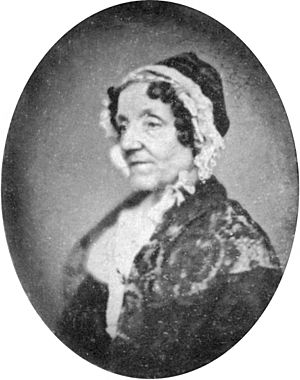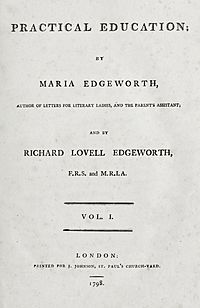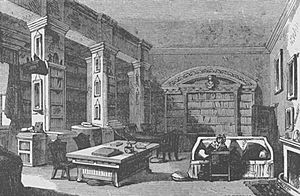Maria Edgeworth facts for kids
Quick facts for kids
Maria Edgeworth
|
|
|---|---|
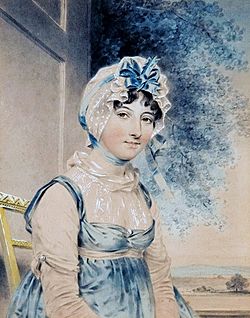
Maria Edgeworth by John Downman, 1807
|
|
| Born | 1 January 1768 Black Bourton, Oxfordshire, England |
| Died | 22 May 1849 (aged 81) Edgeworthstown, County Longford, Ireland |
| Occupation | Writer (novelist) |
| Nationality | British, Irish |
| Period | 18th century |
| Genre | Regionalism, Romantic novel, children's literature |
| Relatives |
|
| Signature | |
Maria Edgeworth (born January 1, 1768 – died May 22, 1849) was a very famous writer from both Ireland and England. She wrote many books for both adults and children. Maria was one of the first writers to create realistic stories for young readers. She also played an important role in how novels developed in Europe. Maria had strong ideas about managing land, politics, and education. She wrote letters to many important writers and thinkers of her time, including Walter Scott and David Ricardo.
About Maria Edgeworth's Life
Her Early Years
Maria Edgeworth was born in Black Bourton, England. She was the second child of Richard Lovell Edgeworth and Anna Maria Edgeworth. When Maria was five, her mother passed away. In 1773, her father married his second wife, Honora Sneyd. Maria then moved with her father to his family home, Edgeworthstown, in County Longford, Ireland.
Maria went to school in Derby and later in London. When she was 14, she returned home. She helped take care of her many younger brothers and sisters. Her father taught her about law, Irish economics, politics, science, and literature at home. She also started writing letters to smart people, especially those in the Lunar Society of Birmingham, a group of important thinkers.
Maria became her father's helper in managing the Edgeworthstown estate. This estate had become a bit run-down. She lived and wrote there for the rest of her life. Maria and her father worked together on many projects. She was known for being very smart and quick-witted. At Edgeworthstown, she lived with her large family, servants, and tenants. She watched and wrote down details of everyday Irish life. She later used these observations in her novels about Ireland.
Her Travels and Friendships
In 1798, Maria's father married Frances Beaufort. Frances, who was almost the same age as Maria, became her close friend. In 1800, the family traveled to London.
In 1802, the Edgeworths visited different parts of England. Then, they traveled to Europe, first to Brussels and then to France. This was during a short peaceful time in the Napoleonic Wars. They met many important people. Maria even received a marriage proposal from a Swedish nobleman, Count Edelcrantz. She returned to Ireland in 1803, just before the wars started again. Maria then focused on her writing.
Her novels like Tales of Fashionable Life, The Absentee, and Ormond are about Irish life. Maria Edgeworth was a very popular author. People often compared her to other famous writers like Jane Austen and Walter Scott. She even earned more money than them at first and used it to help her siblings.
In 1813, Maria visited London and was celebrated as a great writer. She met Lord Byron (whom she didn't like) and Humphry Davy. She started writing many letters to Walter Scott after his novel Waverley came out in 1814. He said her writing had influenced him, and they became good friends. She visited him in Scotland in 1823, and he visited her in Edgeworthstown the next year.
Later Life and Helping Others
Maria's father, Richard Edgeworth, was fair to his tenants and actively managed his estate. After talking with the economist David Ricardo, Maria believed that better management and using science in farming could help produce more food and lower prices. Both Maria and her father supported Catholic emancipation, which meant giving Catholics more rights, including the right to vote. They also supported farming reforms and more education for women. Maria worked hard to improve the lives of poor people in Edgeworthstown. She provided schools for local children of all religions.
After her father died in 1817, Maria edited his life story and added her own thoughts. She continued to write actively until the end of her life.
During the Irish Potato Famine, Maria worked to help the starving Irish people. She wrote a book called Orlandino to raise money for relief. Her letters to the Quaker Relief Committee show how desperate the tenants in Edgeworthstown were. They describe the terrible conditions and her efforts to get help for them. Through her work, she received gifts for the poor from America.
Maria died suddenly from a heart attack in Edgeworthstown on May 22, 1849, when she was in her eighties.
Maria Edgeworth's Ideas
Her Views on Ireland
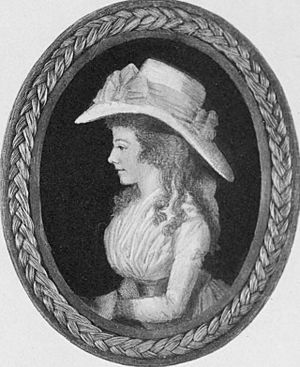
In her books, Maria Edgeworth often created a loving picture of Ireland's past. She wanted to celebrate Irish culture. Her goal was to show that Irish people were just as good as English people. She believed they deserved equal treatment.
Her book Essay on Irish Bulls challenged the common English stereotypes of Irish people. Instead, she showed them accurately in everyday situations. This was a common theme in her Irish works. She wanted to fight against silly caricatures and show real Irish people. She also focused on the differences in language between Irish and English societies. This showed how rich and complex Irish society was, despite what English stereotypes suggested.
Maria believed that education was key to improving both individuals and the nation of Ireland. She thought that a slow process of learning could help Irish people understand other cultures. At the same time, it would keep their strong connection to their own country.
Her Social Views
Maria agreed with the Acts of Union 1800, which joined Ireland and Great Britain. However, she thought it should not have been passed if the Irish people didn't want it. When it came to education, she believed boys and girls should be educated equally and together. She was inspired by the ideas of Jean-Jacques Rousseau.
Maria thought that a woman should only marry someone who matched her in "character, temper, and understanding." She felt it was better to remain unmarried than to be with someone who was not a good match.
Her stories like "Vivian" and Patronage criticized the English government's rule over Ireland in the 1700s. She saw it as unfair and corrupt.
Edgeworth wanted women to achieve their full potential and stressed the importance of each person as an individual. She also wanted middle-class women to be more involved in politics. Her novel Helen clearly shows this idea. In it, a character says that women are now so educated that they cannot avoid having opinions on important public matters. She believed women should not just say, "ladies have nothing to do with politics."
She felt sympathy for Catholics and supported giving them more rights, though she thought it should happen gradually.
Her Ideas on Education
In her 1798 book Practical Education, Maria Edgeworth suggested a scientific way to teach. She said that teaching should be a positive experience. She also believed that learning how to learn was more important in early years than just gaining facts. Her system aimed to adjust teaching methods to fit the child's needs. It also tried to help children understand moral habits and learn by making connections. Most importantly, it aimed to give children responsibility for their own learning. The main goal of Edgeworth's system was to create independent thinkers. These thinkers would understand the results of their own actions.
Maria Edgeworth's Books
Maria Edgeworth's early writings were sometimes seen as overly dramatic. However, her unpublished story The Double Disguise (1786) is now seen as important. It shows her move towards writing realistic stories. It is also considered an early example of regional writing, even before her famous novel Castle Rackrent (1800).
Maria also wrote many children's novels that taught moral lessons. She often worked with her friend Louise Swanton Belloc, a French writer. Louise translated many of Maria's books, which made her popular in France.
Maria's first published work was Letters for Literary Ladies in 1795. This book included "An Essay on the Noble Science of Self-Justification." This essay humorously explored how women could use their wit to challenge men, especially their husbands. In 1796, she published her first children's book, The Parent's Assistant. This book included her famous short story "The Purple Jar." The Parent's Assistant was influenced by her father's ideas on children's education.
Her father, Richard Edgeworth, was a well-known author and inventor. He encouraged Maria's writing career. Maria once wrote, "Seriously it was to please my Father I first exerted myself to write, to please him I continued." Her father approved and edited her work. It is thought that her stepmother and siblings also helped edit her books.
Her first novel, Castle Rackrent (1800), was published without her father knowing. It was an instant success. The book made fun of Anglo-Irish landlords before 1782. It showed that Irish landowners needed to manage their estates more responsibly. The story follows four generations of the Rackrent family. It is told by an Irish Catholic worker named Thady Quirk. The book also showed the rise of the Catholic-Irish middle class.
Belinda (1801) was Maria Edgeworth's first full-length novel. It was about love, dating, and marriage. It showed the struggles between logic and feelings, freedom and rules, and society and the individual. Belinda was also known for showing an interracial marriage between a Black servant and an English farmgirl. However, later versions of the novel removed these parts.
Tales of Fashionable Life (1809 and 1812) was a collection of short stories. They often focused on the lives of women. The second collection was very popular in England. It made her the most successful female novelist of her time. After this, Maria Edgeworth was seen as the top female writer in England, alongside Jane Austen.
In 1815, Maria received a letter from an American Jewish woman named Rachel Mordecai Lazarus. She complained about a negative comment about Jewish people in The Absentee. In response, Maria wrote Harrington (1817) as an apology. This novel was a made-up autobiography about overcoming prejudice against Jewish people. It included one of the first kind and understanding Jewish characters in an English novel.
Helen (1834) was Maria Edgeworth's last novel. It was the only one she wrote after her father died. She chose to focus on the characters and their situation, rather than just moral lessons. She wrote to her publisher, "I have been criticized for making my moral in some stories too obvious. I understand this problem for both the reader and writer. I have worked hard to avoid it in Helen." Her novel was also set in England. Maria chose this because she found Ireland too difficult to write about in the political situation of the 1830s.
Her Writing Style
Maria Edgeworth believed strongly that novels should teach readers. Her books often taught moral and social lessons. She used a style that showed real life and human nature. She also explored how people behave in society.
Maria often used humor and satire in her writing. She was willing to change her style if it helped to make a lesson clear. The lesson might be a warning against bad behavior or against social unfairness.
Maria Edgeworth's writing was very important in her time. She helped to shape how novels were written and how they could teach readers.
List of Published Works
Here is a partial list of her published works:
- Letters for Literary Ladies – 1795
- includes: An Essay on the Noble Science of Self-Justification – 1795
- The Parent's Assistant – 1796
- Practical Education – 1798 (worked with her father and stepmother)
- Castle Rackrent – 1800 (novel)
- Edgeworth, Maria (1801). Early Lessons (1st ed.). London: Johnson. http://hockliffe.dmu.ac.uk/items/0098.html.
- Moral Tales – 1801
- Belinda – 1801 (novel)
- The Mental Thermometer – 1801
- Essay on Irish Bulls – 1802 (political, worked with her father)
- Popular Tales – 1804
- The Modern Griselda – 1804
- Moral Tales for Young People – 1805
- Leonora – 1806
- Essays in Professional Education – 1809
- Tales of Fashionable Life – 1809 and 1812 (includes The Absentee)
- Ennui – 1809 (novel)
- The Absentee – 1812 (novel)
- Patronage – 1814 (novel)
- Harrington – 1817 (novel)
- Ormond – 1817 (novel)
- Comic Dramas – 1817
- Memoirs of Richard Lovell Edgeworth – 1820 (edited her father's life story)
- Rosamond: A Sequel to Early Lessons – 1821
- Frank: A Sequel to Frank in Early Lessons – 1822
- Tomorrow – 1823 (novel)
- Helen – 1834 (novel)
- Orlandino – 1848 (a novel about avoiding alcohol)
Maria Edgeworth's Legacy
From 1800 to 1814, Maria Edgeworth was the most famous and successful English novelist. Her reputation was as great as Frances Burney's had been earlier. Many critics and writers of her time praised her work. For example, Francis Jeffrey called her writing "perfect."
The Ulster Gaelic Society, formed in 1830, translated two of Maria Edgeworth's stories into Irish. These were "Forgive and Forget" and "Rosanna."
Images for kids
See also
 In Spanish: Maria Edgeworth para niños
In Spanish: Maria Edgeworth para niños



